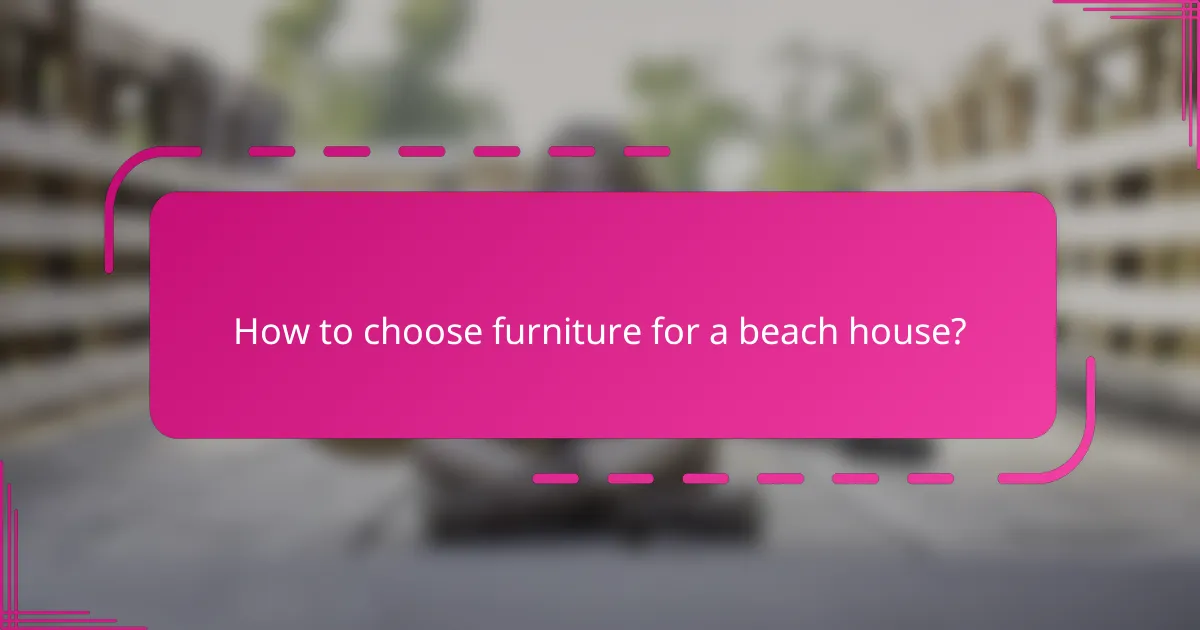Designing a beach house centers around creating a serene retreat that emphasizes relaxation and comfort. By incorporating coastal colors like soft blues and greens, along with an airy layout that maximizes natural light and open spaces, the home fosters a seamless connection to the outdoors, inviting tranquility into everyday life.

How to design a beach house for relaxation?
Designing a beach house for relaxation involves creating an environment that promotes comfort and tranquility. Key elements include open spaces, ample natural light, and a seamless connection to the outdoors.
Open floor plans
Open floor plans are essential in beach house design as they enhance airflow and create a sense of spaciousness. By eliminating unnecessary walls, you can foster a more inviting atmosphere that encourages social interaction and relaxation.
Consider integrating the living, dining, and kitchen areas into one cohesive space. This layout not only maximizes the use of natural light but also allows for easy movement and flow throughout the home.
Natural light incorporation
Incorporating natural light is crucial for a relaxing beach house environment. Large windows, skylights, and sliding glass doors can help flood the interior with sunlight, creating a warm and inviting atmosphere.
Position windows to capture views of the ocean or surrounding landscapes. Using light, sheer curtains can soften the light while maintaining privacy, ensuring that the space remains bright and airy.
Outdoor living spaces
Outdoor living spaces extend your beach house’s usable area and enhance relaxation. Decks, patios, and porches provide perfect spots for lounging, dining, or enjoying the coastal breeze.
Consider adding comfortable furniture, shade structures, and even outdoor kitchens to create a seamless transition between indoor and outdoor living. This connection to nature can significantly enhance your overall relaxation experience.
Coastal color palettes
Choosing a coastal color palette is vital for establishing a serene atmosphere in your beach house. Soft blues, sandy beiges, and crisp whites evoke the feeling of the beach and promote relaxation.
Use these colors on walls, furnishings, and decor to create a cohesive look. Accents in coral or seafoam green can add pops of color while maintaining a tranquil vibe, making your beach house a peaceful retreat.

What are the best coastal colors for a beach house?
The best coastal colors for a beach house include soft blues, greens, and neutral tones that evoke a sense of tranquility and connection to nature. These colors not only enhance the airy layout of the space but also promote relaxation, making them ideal for a coastal retreat.
Soft blues and greens
Soft blues and greens are quintessential coastal colors that mimic the ocean and sky. Shades like seafoam green or light aqua can create a serene atmosphere, while deeper blues can add depth and sophistication. Consider using these colors on walls, furniture, or decor to establish a calming environment.
When selecting soft blues and greens, aim for hues that reflect natural elements. For example, pairing a pale blue with sandy beige can create a harmonious look reminiscent of beach landscapes. Test paint samples in different lighting to see how they change throughout the day.
Neutral whites and beiges
Neutral whites and beiges serve as a perfect backdrop for a beach house, providing a clean and airy feel. These colors can make spaces appear larger and brighter, allowing natural light to bounce around the room. They also work well with a variety of accent colors and textures.
To achieve a cohesive look, consider using warm whites or soft beiges that complement the coastal theme. Avoid stark whites that can feel too cold; instead, opt for shades with undertones that reflect the warmth of sand or driftwood.
Accent colors like coral
Accent colors like coral can add vibrant pops to a beach house, creating visual interest without overwhelming the space. Coral pairs beautifully with soft blues and greens, enhancing the coastal aesthetic while providing a cheerful contrast. Use it in accessories like cushions, artwork, or decorative items.
When incorporating coral, balance it with neutral tones to maintain a relaxed atmosphere. A few strategically placed coral accents can invigorate a room, making it feel lively yet still connected to the serene coastal theme.

What layout features enhance relaxation in beach houses?
Beach houses often incorporate specific layout features that promote relaxation, such as ample natural light, open spaces, and seamless transitions between indoor and outdoor areas. These design elements create a tranquil atmosphere that encourages unwinding and enjoying the coastal environment.
Large windows for ocean views
Large windows are a hallmark of beach house design, allowing for breathtaking ocean views and abundant natural light. These expansive glass panels not only enhance the aesthetic appeal but also create a connection with the surrounding landscape, making the interior feel more spacious and inviting.
When selecting windows, consider energy-efficient options that minimize heat gain while maximizing visibility. Look for double or triple-glazed glass to ensure comfort during warmer months, especially in coastal climates where temperatures can fluctuate.
Open-concept living areas
Open-concept living areas are essential in beach houses, as they facilitate a free flow of movement and foster social interactions. By removing unnecessary walls, these layouts create a sense of spaciousness and allow for better air circulation, which is crucial in humid coastal environments.
To enhance the open feel, use light-colored furnishings and decor that reflect the coastal theme. Incorporating multi-functional furniture, such as a dining table that doubles as a workspace, can further optimize space while maintaining a relaxed atmosphere.
Private outdoor spaces
Private outdoor spaces, such as patios or decks, are vital for relaxation in beach houses. These areas serve as extensions of the living space, providing a serene environment for sunbathing, dining, or simply enjoying the ocean breeze. Consider incorporating comfortable seating and shade options to maximize usability.
When designing outdoor spaces, prioritize materials that withstand coastal weather, such as treated wood or composite decking. Adding elements like outdoor lighting and fire pits can enhance the ambiance, making these areas perfect for evening gatherings or quiet reflection under the stars.

What are the key materials for beach house construction?
Key materials for beach house construction focus on durability and aesthetics, ensuring they withstand coastal conditions while providing a relaxing atmosphere. Common choices include weather-resistant wood, composite decking, and expansive glass features.
Weather-resistant wood
Weather-resistant wood, such as cedar or redwood, is essential for beach houses due to its natural resistance to moisture and pests. These woods can endure the salty air and humidity typical of coastal environments, making them ideal for structural elements and outdoor features.
When selecting weather-resistant wood, consider treatments that enhance longevity, such as sealants or stains. Regular maintenance, like cleaning and reapplying protective coatings, can extend the life of wooden components significantly.
Composite decking
Composite decking offers a low-maintenance alternative to traditional wood, combining recycled materials with plastic to create a durable surface. This material resists fading, splintering, and warping, making it suitable for beachside settings where exposure to the elements is constant.
When choosing composite decking, look for products with a high percentage of recycled content and a warranty that covers fading and structural integrity. This can provide peace of mind and reduce long-term costs associated with repairs or replacements.
Glass for panoramic views
Using glass in beach house design enhances natural light and provides stunning panoramic views of the coastline. Large windows and sliding glass doors can create a seamless transition between indoor and outdoor spaces, promoting relaxation and connection to nature.
When incorporating glass, consider energy-efficient options that offer UV protection and insulation. This can help maintain comfortable indoor temperatures and protect furnishings from sun damage, ensuring a pleasant living environment year-round.

How to choose furniture for a beach house?
Choosing furniture for a beach house involves selecting pieces that enhance relaxation while withstanding coastal conditions. Focus on lightweight, durable materials and a coastal aesthetic to create a serene and inviting atmosphere.
Lightweight and durable materials
When selecting furniture for a beach house, prioritize lightweight and durable materials such as aluminum, teak, or synthetic wicker. These materials resist corrosion and fading from saltwater and sun exposure, ensuring longevity.
Consider options like outdoor cushions made from quick-drying foam and UV-resistant fabrics. This combination allows for easy movement and maintenance, making it ideal for a relaxed beach lifestyle.
Coastal-themed decor
Incorporate coastal-themed decor to enhance the beach house ambiance. Use colors inspired by the ocean, such as soft blues, sandy beiges, and crisp whites, to create a calming palette.
Accessorize with items like seashells, driftwood, and nautical motifs. These elements not only reflect the coastal environment but also add character and warmth to your space.
Functional outdoor furniture
Invest in functional outdoor furniture that encourages relaxation and socializing. Look for items like lounge chairs, hammocks, and dining sets designed for outdoor use, ensuring they are weather-resistant.
Consider multipurpose pieces, such as storage benches that provide seating while keeping beach gear organized. This approach maximizes space and enhances the overall functionality of your beach house.

What are the benefits of an airy layout?
An airy layout enhances the overall living experience by promoting comfort and relaxation. It facilitates better airflow and natural light, creating a serene environment ideal for unwinding in a beach house.
Improved airflow
Improved airflow is a key advantage of an airy layout, as it allows fresh air to circulate freely throughout the space. This can be achieved through strategic placement of windows, doors, and ventilation systems, which help reduce humidity and improve indoor air quality.
To maximize airflow, consider using large, operable windows that can be opened to create cross-ventilation. This is especially beneficial in coastal areas where breezes can help cool the home naturally, reducing reliance on air conditioning.
Enhanced natural light
Enhanced natural light is another significant benefit of an airy layout, which can make spaces feel larger and more inviting. By incorporating large windows, skylights, and open spaces, you can allow sunlight to flood in, creating a bright and cheerful atmosphere.
When designing for natural light, orient windows to capture sunlight during peak hours and consider using light-colored furnishings and surfaces to reflect light. This not only improves the aesthetic appeal but can also reduce energy costs by minimizing the need for artificial lighting during the day.
